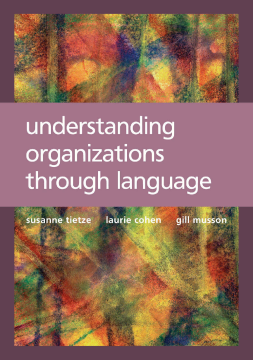
BOOK
Understanding Organizations through Language:
Susanne Tietze, Laurie Cohen and Gill Musson
(2003)
Additional Information
Book Details
Abstract
Offering a viable alternative to 'functional' approaches to communication based around the metaphor of 'webs of meaning' and using semiology as its theoretical bedrock, the authors provide examples and argue how and why this approach is useful in understanding communicative processes. This approach is applied to areas of interest, including: metaphor, story-telling, discourse, gender, leadership and electronic communication.
Table of Contents
| Section Title | Page | Action | Price |
|---|---|---|---|
| 1. Introduction | |||
| 1.1 The challenge of urban sanitation | |||
| 1.2 The purpose and intended readership of this book | |||
| 1.3 Definitions and meanings | |||
| 1.4 The need for treatment | |||
| 1.5 The sanitation service chain | |||
| 1.6 The objectives of faecal sludge and septage treatment | |||
| 1.7 Key indicators and measures | |||
| 1.8 How this book relates to other publications | |||
| 1.9 Structure of book and brief description of contents | |||
| 1.10 References | |||
| 2. Faecal sludge and septage treatment in context | |||
| 2.1 Faecal sludge and septage treatment as part of the sanitation chain | |||
| 2.2 Options for faecal sludge and septage disposal | |||
| 2.3 Private and public needs and the importance of demand | |||
| 2.4 Legislation | |||
| 2.5 Institutional structures, systems and capacities | |||
| 2.6 Resources – Finance | |||
| 2.7 Other external factors that influence treatment choices | |||
| 2.8 Potential changes in faecal sludge and septage management | |||
| 2.9 Summary of faecal sludge and septage treatment context | |||
| 2.10 References | |||
| 3. Planning for Improved Treatment | |||
| 3.1 Introduction | |||
| 3.2 Overview of treatment plant planning and design process | |||
| 3.3 Preliminary assessment | |||
| 3.4 Develop consensus on the need for faecal sludge and septage treatment | |||
| 3.5 Determining the planning area, the plant service area and location | |||
| 3.6 Load assessment | |||
| 3.7 Assessment of hydraulic loading | |||
| 3.8 Technology choices | |||
| 3.9 Summary on improved treatment planning | |||
| 3.10 References | |||
| 4. Introduction to treatment processes and technologies | |||
| 4.1 Treatment objectives | |||
| 4.2 Dealing with high strength, partly stabilised faecal sludge and septage | |||
| 4.3 Introduction to treatment units and their functionss | |||
| 4.4 Co-treatment with wastewater | |||
| 4.5 Decision making guidance for technology selection | |||
| 4.6 Summary and Key Takeaways | |||
| 4.7 References | |||
| 5. Planning and designing for effective operation | |||
| 5.1 Taking account of the operational context | |||
| 5.2 Institutional influences on operational capacity | |||
| 5.3 Common operational problems | |||
| 5.4 Best design practices to mitigate common operation problems | |||
| 5.5 Summary and Key Takeaways | |||
| 5.6 References | |||
| 6. Faecal sludge and septage receiving and preliminary treatment | |||
| 6.1 Introduction | |||
| 6.2 Receiving Facilities | |||
| 6.3 Preliminary Treatment | |||
| 6.4 Partial digestion | |||
| 6.5 Equalization | |||
| 6.6 Summary and Key Takeaways | |||
| 6.7 References | |||
| 7. Solids - liquid separation | |||
| 7.1 Introduction to solids – liquid separation | |||
| 7.2 Sludge Drying Beds | |||
| 7.3 Anaerobic Ponds | |||
| 7.4 Settling Thickening Tanks | |||
| 7.5 Gravity Thickeners | |||
| 7.6 Decanting drying beds | |||
| 7.7 Mechanical presses | |||
| 7.8 Summary and Comparison of Technology Options | |||
| 7.9 References | |||
| 8. Liquid Treatment | |||
| 8.1 Introduction to liquid treatment processes | |||
| 8.2 Anaerobic treatment | |||
| 8.3 Additional biological and aerobic treatment | |||
| 8.4 Pathogen reduction and polishing | |||
| 8.5 Other common wastewater technologies not recommended for liquid stream of septage and faecal sludge treatment | |||
| 8.6 Co-treating liquid stream of septage and faecal sludge with wastewater | |||
| 8.7 Summary and comparison of technology options for liquid treatment | |||
| 8.8 References | |||
| 9. Solids Treatment with Focus on Dewatering | |||
| 9.1 Introduction to solids dewatering | |||
| 9.2 Technologies for dewatering | |||
| 9.3 Summary and Key Takeaways | |||
| 9.4 References | |||
| 10. Additional Treatment for Solids Disposal and Safe Enduse | |||
| 10.1 Introduction | |||
| 10.2 Preconditions for solids end use | |||
| 10.3 Treatment options | |||
| 10.4 Drying | |||
| 10.5 Thermal processes | |||
| 10.6 Other processes | |||
| 10.7 Summary and Key Takeaways | |||
| 10.8 References |
